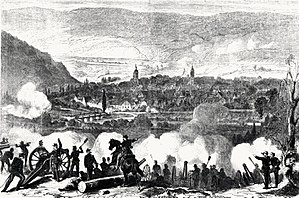Battle of Tauberbischofsheim
| Battle of Tauberbischofsheim | |||||||
|---|---|---|---|---|---|---|---|
| Part of the Austro-Prussian War | |||||||
 Württemberg artillery in the battle | |||||||
| |||||||
| Belligerents | |||||||
|
|
| ||||||
| Commanders and leaders | |||||||
|
|
| ||||||
| Strength | |||||||
| 60,000 | 42,000 (VIII Army Corps) | ||||||
| Casualties and losses | |||||||
|
16 killed 107 wounded 3 missed or captured Total: 126 |
62 killed 455 wounded 192 missed or captured Total: 709[1] | ||||||
The Battle of Tauberbischofsheim was an engagement of the Austro-Prussian War of 1866, on the 24 July at Tauberbischofsheim in the Grand Duchy of Baden between troops of the German Confederation and the Kingdom of Prussia. It was part of the campaign of the Main and ended with a Prussian victory.
Preliminary campaign[]
After the Prussian Mainarmee (German for: army of the river Main) had beaten the Bavarians at Kissingen, the Bavarian army retreated to Würzburg. The Prussians now turned west against the VIIIth Federal Corps (troops of Württemberg, Baden, Hesse and Nassau) which protected Frankfurt. After the VIIIth Corps had lost combats at Frohnhofen and Aschaffenburg it gave up the defence of Frankfurt and went south-eastward to unite with the Bavarians at the river Tauber. The Prussian army followed.
The battle[]

The VIIIth Corps, consisting of four divisions under the command of Alexander von Hessen-Darmstadt, was distributed to the following places on the day of the battle: The Württemberg division was in the centre at Tauberbischofsheim, the Baden division on the right flank at Werbach, the Grand Ducal Hessian division at Großrinderfeld and a division mixed of troops from Austria and Nassau on the left flank at Grünsfeld-Paimar. The Prussians were able to push back the federal troops in Tauberbischofsheim. The counter attacks failed and troops of Württemberg suffered a comprehensive defeat. At Werbach the troops of Baden were also beaten.[2]
Aftermath[]
After further clashes the next two days at Gerchsheim, Uettingen, Helmstadt and Roßbrunn, which ended in favor of the Prussians, the federal troops withdrew to Würzburg where a truce ended the fightings. The Prussians occupied northern Württemberg and negotiated a peace in August 1866. Württemberg paid an indemnity of 8,000,000 gulden, and concluded a secret offensive and defensive treaty with her conqueror.
Although not officially part of the North German Confederation, the secret treaty effectively bound Württemberg to Prussia. Few years later, in 1870, Württemberger troops played a creditable part in the Battle of Wörth and in other operations of the Franco-Prussian War. In 1871, Württemberg became a member of the new German Empire.
Memorials[]

Monument to the Wurttemberg Fallen

Monument to the Wurttemberg Fallen
References[]
- ^ Österreichs Kämpfe im Jahre 1866. Nach Feldacten bearbeitet durch das k.k. Generalstabs-Bureau für Kriegsgeschichte. Fünfter Band (Vol. 5), Vienna 1869, chapter: Die Kriegsereignisse in Westdeutschland im Jahre 1866, III. Abschnitt, p. 141 (scan p. 315) digitalised
- ^ Theodor Fontane: Der deutsche Krieg von 1866. Der Feldzug in West- und Mitteldeutschland. Berlin 1871. p. 214-221 digitalised
49°37′21″N 09°39′46″E / 49.62250°N 9.66278°ECoordinates: 49°37′21″N 09°39′46″E / 49.62250°N 9.66278°E
External links[]
- Battles of the Austro-Prussian War
- Battles involving Austria
- Battles involving Prussia
- 1866 in Baden
- July 1866 events
- 1866 in Germany
- Battles in Baden-Württemberg
- Austrian battle stubs
- German battle stubs


 WikiMiniAtlas
WikiMiniAtlas